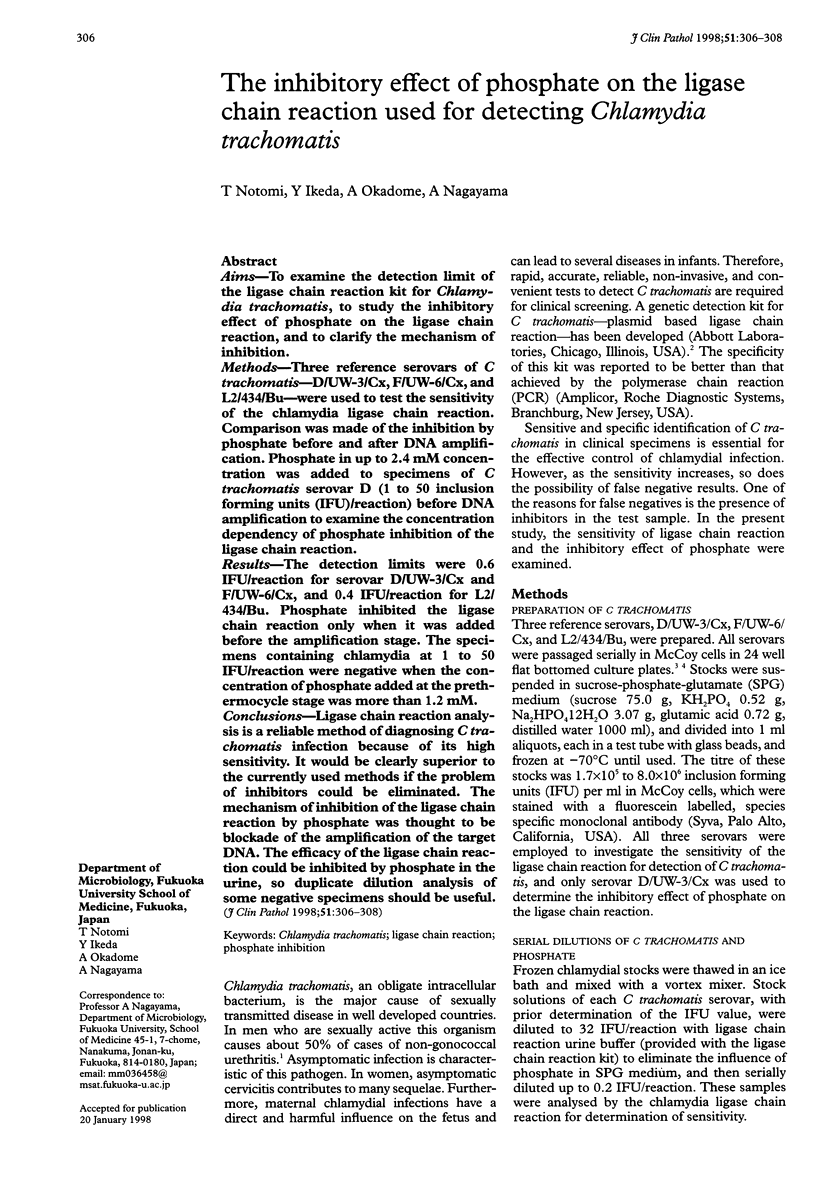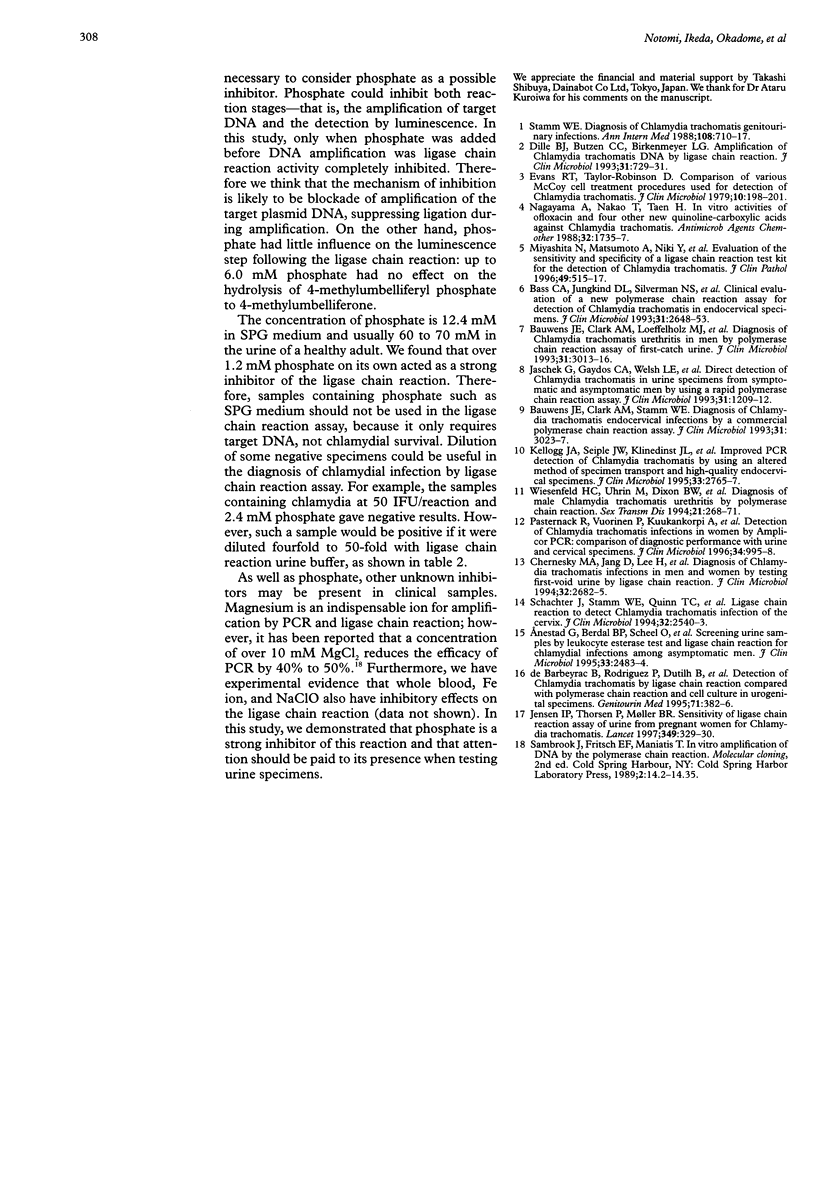Abstract
AIMS: To examine the detection limit of the ligase chain reaction kit for Chlamydia trachomatis, to study the inhibitory effect of phosphate on the ligase chain reaction, and to clarify the mechanism of inhibition. METHODS: Three reference serovars of C trachomatis--D/UW-3/Cx, F/UW-6/Cx, and L2/434/Bu--were used to test the sensitivity of the chlamydia ligase chain reaction. Comparison was made of the inhibition by phosphate before and after DNA amplification. Phosphate in up to 2.4 mM concentration was added to specimens of C trachomatis serovar D (1 to 50 inclusion forming units (IFU)/reaction) before DNA amplification to examine the concentration dependency of phosphate inhibition of the ligase chain reaction. RESULTS: The detection limits were 0.6 IFU/reaction for serovar D/UW-3/Cx and F/UW-6/Cx, and 0.4 IFU/reaction for L2/434/Bu. Phosphate inhibited the ligase chain reaction only when it was added before the amplification stage. The specimens containing chlamydia at 1 to 50 IFU/reaction were negative when the concentration of phosphate added at the prethermocycle stage was more than 1.2 mM. CONCLUSIONS: Ligase chain reaction analysis is a reliable method of diagnosing C trachomatis infection because of its high sensitivity. It would be clearly superior to the currently used methods if the problem of inhibitors could be eliminated. The mechanism of inhibition of the ligase chain reaction by phosphate was thought to be blockade of the amplification of the target DNA. The efficacy of the ligase chain reaction could be inhibited by phosphate in the urine, so duplicate dilution analysis of some negative specimens should be useful.
Full text
PDF


Selected References
These references are in PubMed. This may not be the complete list of references from this article.
- Anestad G., Berdal B. P., Scheel O., Mundal R., Odinsen O., Skaug K., Khalil O. S., Plier P., Lee H. Screening urine samples by leukocyte esterase test and ligase chain reaction for chlamydial infections among asymptomatic men. J Clin Microbiol. 1995 Sep;33(9):2483–2484. doi: 10.1128/jcm.33.9.2483-2484.1995. [DOI] [PMC free article] [PubMed] [Google Scholar]
- Bass C. A., Jungkind D. L., Silverman N. S., Bondi J. M. Clinical evaluation of a new polymerase chain reaction assay for detection of Chlamydia trachomatis in endocervical specimens. J Clin Microbiol. 1993 Oct;31(10):2648–2653. doi: 10.1128/jcm.31.10.2648-2653.1993. [DOI] [PMC free article] [PubMed] [Google Scholar]
- Bauwens J. E., Clark A. M., Loeffelholz M. J., Herman S. A., Stamm W. E. Diagnosis of Chlamydia trachomatis urethritis in men by polymerase chain reaction assay of first-catch urine. J Clin Microbiol. 1993 Nov;31(11):3013–3016. doi: 10.1128/jcm.31.11.3013-3016.1993. [DOI] [PMC free article] [PubMed] [Google Scholar]
- Bauwens J. E., Clark A. M., Stamm W. E. Diagnosis of Chlamydia trachomatis endocervical infections by a commercial polymerase chain reaction assay. J Clin Microbiol. 1993 Nov;31(11):3023–3027. doi: 10.1128/jcm.31.11.3023-3027.1993. [DOI] [PMC free article] [PubMed] [Google Scholar]
- Chernesky M. A., Jang D., Lee H., Burczak J. D., Hu H., Sellors J., Tomazic-Allen S. J., Mahony J. B. Diagnosis of Chlamydia trachomatis infections in men and women by testing first-void urine by ligase chain reaction. J Clin Microbiol. 1994 Nov;32(11):2682–2685. doi: 10.1128/jcm.32.11.2682-2685.1994. [DOI] [PMC free article] [PubMed] [Google Scholar]
- Dille B. J., Butzen C. C., Birkenmeyer L. G. Amplification of Chlamydia trachomatis DNA by ligase chain reaction. J Clin Microbiol. 1993 Mar;31(3):729–731. doi: 10.1128/jcm.31.3.729-731.1993. [DOI] [PMC free article] [PubMed] [Google Scholar]
- Evans R. T., Taylor-Robinson D. Comparison of various McCoy cell treatment procedures used for detection of Chlamydia trachomatis. J Clin Microbiol. 1979 Aug;10(2):198–201. doi: 10.1128/jcm.10.2.198-201.1979. [DOI] [PMC free article] [PubMed] [Google Scholar]
- Jaschek G., Gaydos C. A., Welsh L. E., Quinn T. C. Direct detection of Chlamydia trachomatis in urine specimens from symptomatic and asymptomatic men by using a rapid polymerase chain reaction assay. J Clin Microbiol. 1993 May;31(5):1209–1212. doi: 10.1128/jcm.31.5.1209-1212.1993. [DOI] [PMC free article] [PubMed] [Google Scholar]
- Jensen I. P., Thorsen P., Møller B. R. Sensitivity of ligase chain reaction assay of urine from pregnant women for Chlamydia trachomatis. Lancet. 1997 Feb 1;349(9048):329–330. doi: 10.1016/s0140-6736(05)62829-2. [DOI] [PubMed] [Google Scholar]
- Kellogg J. A., Seiple J. W., Klinedinst J. L., Stroll E. S., Cavanaugh S. H. Improved PCR detection of Chlamydia trachomatis by using an altered method of specimen transport and high-quality endocervical specimens. J Clin Microbiol. 1995 Oct;33(10):2765–2767. doi: 10.1128/jcm.33.10.2765-2767.1995. [DOI] [PMC free article] [PubMed] [Google Scholar]
- Miyashita N., Matsumoto A., Niki Y., Matsushima T. Evaluation of the sensitivity and specificity of a ligase chain reaction test kit for the detection of Chlamydia trachomatis. J Clin Pathol. 1996 Jun;49(6):515–517. doi: 10.1136/jcp.49.6.515. [DOI] [PMC free article] [PubMed] [Google Scholar]
- Nagayama A., Nakao T., Taen H. In vitro activities of ofloxacin and four other new quinoline-carboxylic acids against Chlamydia trachomatis. Antimicrob Agents Chemother. 1988 Nov;32(11):1735–1737. doi: 10.1128/aac.32.11.1735. [DOI] [PMC free article] [PubMed] [Google Scholar]
- Pasternack R., Vuorinen P., Kuukankorpi A., Pitkäjärvi T., Miettinen A. Detection of Chlamydia trachomatis infections in women by Amplicor PCR: comparison of diagnostic performance with urine and cervical specimens. J Clin Microbiol. 1996 Apr;34(4):995–998. doi: 10.1128/jcm.34.4.995-998.1996. [DOI] [PMC free article] [PubMed] [Google Scholar]
- Schachter J., Stamm W. E., Quinn T. C., Andrews W. W., Burczak J. D., Lee H. H. Ligase chain reaction to detect Chlamydia trachomatis infection of the cervix. J Clin Microbiol. 1994 Oct;32(10):2540–2543. doi: 10.1128/jcm.32.10.2540-2543.1994. [DOI] [PMC free article] [PubMed] [Google Scholar]
- Stamm W. E. Diagnosis of Chlamydia trachomatis genitourinary infections. Ann Intern Med. 1988 May;108(5):710–717. doi: 10.7326/0003-4819-108-5-710. [DOI] [PubMed] [Google Scholar]
- Wiesenfeld H. C., Uhrin M., Dixon B. W., Sweet R. L. Diagnosis of male Chlamydia trachomatis urethritis by polymerase chain reaction. Sex Transm Dis. 1994 Sep-Oct;21(5):268–271. doi: 10.1097/00007435-199409000-00004. [DOI] [PubMed] [Google Scholar]
- de Barbeyrac B., Rodriguez P., Dutilh B., Le Roux P., Bébéar C. Detection of Chlamydia trachomatis by ligase chain reaction compared with polymerase chain reaction and cell culture in urogenital specimens. Genitourin Med. 1995 Dec;71(6):382–386. doi: 10.1136/sti.71.6.382. [DOI] [PMC free article] [PubMed] [Google Scholar]


